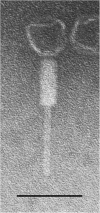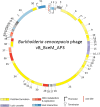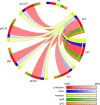The temperate Burkholderia phage AP3 of the Peduovirinae shows efficient antimicrobial activity against B. cenocepacia of the IIIA lineage
- PMID: 27770178
- PMCID: PMC5247547
- DOI: 10.1007/s00253-016-7924-7
The temperate Burkholderia phage AP3 of the Peduovirinae shows efficient antimicrobial activity against B. cenocepacia of the IIIA lineage
Abstract
Burkholderia phage AP3 (vB_BceM_AP3) is a temperate virus of the Myoviridae and the Peduovirinae subfamily (P2likevirus genus). This phage specifically infects multidrug-resistant clinical Burkholderia cenocepacia lineage IIIA strains commonly isolated from cystic fibrosis patients. AP3 exhibits high pairwise nucleotide identity (61.7 %) to Burkholderia phage KS5, specific to the same B. cenocepacia host, and has 46.7-49.5 % identity to phages infecting other species of Burkholderia. The lysis cassette of these related phages has a similar organization (putative antiholin, putative holin, endolysin, and spanins) and shows 29-98 % homology between specific lysis genes, in contrast to Enterobacteria phage P2, the hallmark phage of this genus. The AP3 and KS5 lysis genes have conserved locations and high amino acid sequence similarity. The AP3 bacteriophage particles remain infective up to 5 h at pH 4-10 and are stable at 60 °C for 30 min, but are sensitive to chloroform, with no remaining infective particles after 24 h of treatment. AP3 lysogeny can occur by stable genomic integration and by pseudo-lysogeny. The lysogenic bacterial mutants did not exhibit any significant changes in virulence compared to wild-type host strain when tested in the Galleria mellonella moth wax model. Moreover, AP3 treatment of larvae infected with B. cenocepacia revealed a significant increase (P < 0.0001) in larvae survival in comparison to AP3-untreated infected larvae. AP3 showed robust lytic activity, as evidenced by its broad host range, the absence of increased virulence in lysogenic isolates, the lack of bacterial gene disruption conditioned by bacterial tRNA downstream integration site, and the absence of detected toxin sequences. These data suggest that the AP3 phage is a promising potent agent against bacteria belonging to the most common B. cenocepacia IIIA lineage strains.
Keywords: Burkholderia cepacia lineage IIIA; Peduovirinae; Temperate phage.
Conflict of interest statement
The authors declare that they have no competing interests. Ethical approval This article does not contain any studies with human participants or animals performed by any of the authors.
Figures






Similar articles
-
Characterization and Comparative Genomic Analysis of vB_BceM_CEP1: A Novel Temperate Bacteriophage Infecting Burkholderia cepacia Complex.J Microbiol. 2024 Nov;62(11):1035-1055. doi: 10.1007/s12275-024-00185-2. Epub 2024 Nov 18. J Microbiol. 2024. PMID: 39557803
-
Genomic analysis and relatedness of P2-like phages of the Burkholderia cepacia complex.BMC Genomics. 2010 Oct 25;11:599. doi: 10.1186/1471-2164-11-599. BMC Genomics. 2010. PMID: 20973964 Free PMC article.
-
Genomic characterization of JG068, a novel virulent podovirus active against Burkholderia cenocepacia.BMC Genomics. 2013 Aug 27;14:574. doi: 10.1186/1471-2164-14-574. BMC Genomics. 2013. PMID: 23978260 Free PMC article.
-
Burkholderia cenocepacia in cystic fibrosis: epidemiology and molecular mechanisms of virulence.Clin Microbiol Infect. 2010 Jul;16(7):821-30. doi: 10.1111/j.1469-0691.2010.03237.x. Clin Microbiol Infect. 2010. PMID: 20880411 Review.
-
The promise of bacteriophage therapy for Burkholderia cepacia complex respiratory infections.Front Cell Infect Microbiol. 2012 Jan 20;1:27. doi: 10.3389/fcimb.2011.00027. eCollection 2011. Front Cell Infect Microbiol. 2012. PMID: 22919592 Free PMC article. Review.
Cited by
-
Characterization and Comparative Genomic Analysis of vB_BceM_CEP1: A Novel Temperate Bacteriophage Infecting Burkholderia cepacia Complex.J Microbiol. 2024 Nov;62(11):1035-1055. doi: 10.1007/s12275-024-00185-2. Epub 2024 Nov 18. J Microbiol. 2024. PMID: 39557803
-
The Isolation and Characterization of a Broad Host Range Bcep22-like Podovirus JC1.Viruses. 2022 Apr 29;14(5):938. doi: 10.3390/v14050938. Viruses. 2022. PMID: 35632679 Free PMC article.
-
Comparative Genomics of Environmental and Clinical Burkholderia cenocepacia Strains Closely Related to the Highly Transmissible Epidemic ET12 Lineage.Front Microbiol. 2018 Mar 6;9:383. doi: 10.3389/fmicb.2018.00383. eCollection 2018. Front Microbiol. 2018. PMID: 29559964 Free PMC article.
-
Harnessing the diversity of Burkholderia spp. prophages for therapeutic potential.bioRxiv [Preprint]. 2024 Jan 25:2024.01.24.577087. doi: 10.1101/2024.01.24.577087. bioRxiv. 2024. Update in: Cells. 2024 Feb 29;13(5):428. doi: 10.3390/cells13050428. PMID: 38328162 Free PMC article. Updated. Preprint.
-
Burkholderia cenocepacia Prophages-Prevalence, Chromosome Location and Major Genes Involved.Viruses. 2018 May 31;10(6):297. doi: 10.3390/v10060297. Viruses. 2018. PMID: 29857552 Free PMC article.
References
-
- Abedon ST. Bacteriophages and biofilms: ecology, phage therapy, plaques. New York: Nova Science Publishers; 2011.
-
- Ackermann HW. Classification of bacteriophages. In: Calendar R, editor. The bacteriophages. 2nd. New York: Oxford University Press; 2006. pp. 8–16.
-
- Adams M. Bacteriophages. New York: Interscience; 1959. pp. 137–159.
MeSH terms
Substances
LinkOut - more resources
Full Text Sources
Other Literature Sources

